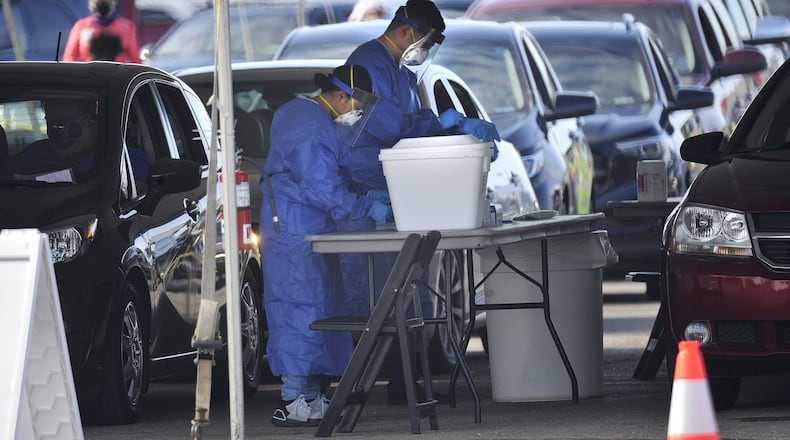Butler County remained at Level 3 in the update. It stayed below the state threshold for indicators including emergency room visits with COVID-19-like symptoms and hospital admissions, but it continues to have high metrics for cases per capita and visits to primary care physicians with COVID-19-like symptoms.
The county also passed 15,000 cases this week, with 15,514 reported on Wednesday. That came three weeks after it passed 10,000 cases, and there has been a 16.4% increase in the past week.
Montgomery, Lake and Lorain counties were moved to purple in the alert system because they are experiencing sustained increases in outpatient, emergency, and hospital visits by COVID-19 patients, according to a release from the Ohio Department of Health. Franklin County stayed at level 4 for a second week.
The purple Level 4 means there is “severe exposure and spread” of COVID-19. The color is meant as a warning to residents to heed health recommendations, but the state does not impose further restrictions on counties based on the alert level.
Ohio Gov. Mike DeWine previously said guidance for residents living in areas with the highest warning is to stay home except for necessary travel to get supplies and services. Given the exponential spread and thin hospital capacity, Montgomery County residents were already advised to stay home unless necessary to go out.
“The ongoing high prevalence of the virus throughout Ohio, as reflected in today’s alert system update, is very dangerous as we move into the holidays,” said DeWine. “We have heard again this week from hospital administrators and front-line staff about how they are overwhelmed. It is imperative that Ohioans take the virus and this current situation seriously.”
The elevation counties to the highest alert level follows more than a month of increasing case numbers and weeks of increased hospitalizations. ODH notes that 10 of the 11 counties on the level 4 watch list are in the Akron and Cincinnati regions, which now are seeing increased demand for adult ICU beds due to increases in COVID-19 ICU patients.
The seven indicators:
- New cases per capita: There have been more than 50 cases per 100,000 residents over the past two weeks.
- Sustained increase in new cases: At some time during the past three weeks, there were at least five consecutive days when the number of cases (by onset date) increased.
- Proportion of cases not in a congregate setting: The proportion of cases among people who are not residents of long-term care facilities, group homes, jails or prisons has been more than 50% in at least one of the past three weeks.
- Sustained increase in emergency department visits for COVID-19 like illness: At some point during the past three weeks, there were at least five consecutive days when the number of people making COVID-19 health care visits increased.
- Sustained increase in outpatient visits for COVID-19 like illness: At some time during the past three weeks, there were at least five consecutive days when the number of people making COVID-19 health care visits increased.
- Sustained increase in new COVID-19 hospital admissions: At some time during the past three weeks, there were at least five consecutive days when COVID-19 hospital admissions increased.
- Intensive care unit: The percentage of occupied ICU beds in the region was above 80% for at least three days during the past week AND more than 20% of ICU beds were being used for COVID-19 patients for at least three days during the past week.
About the Author
